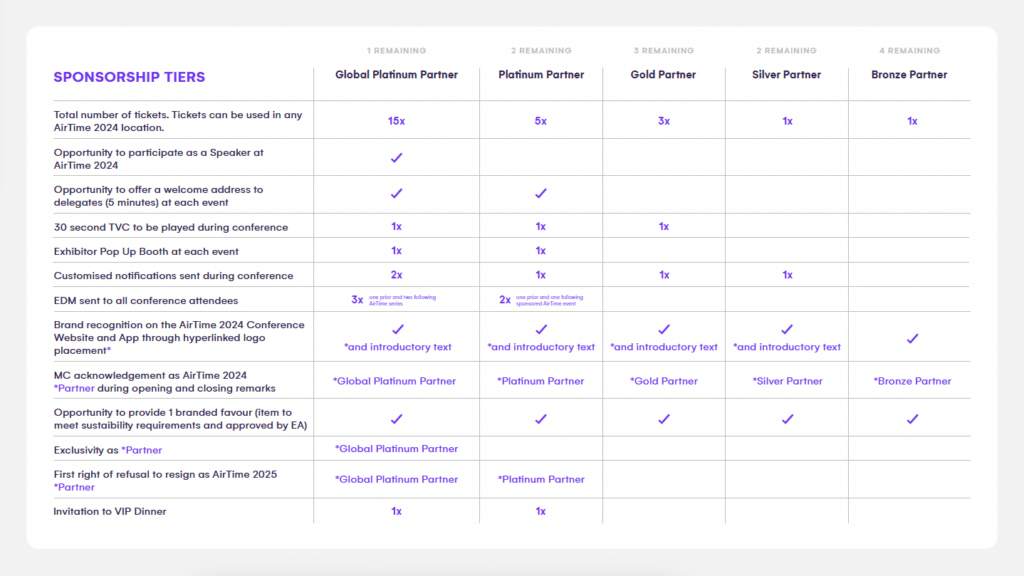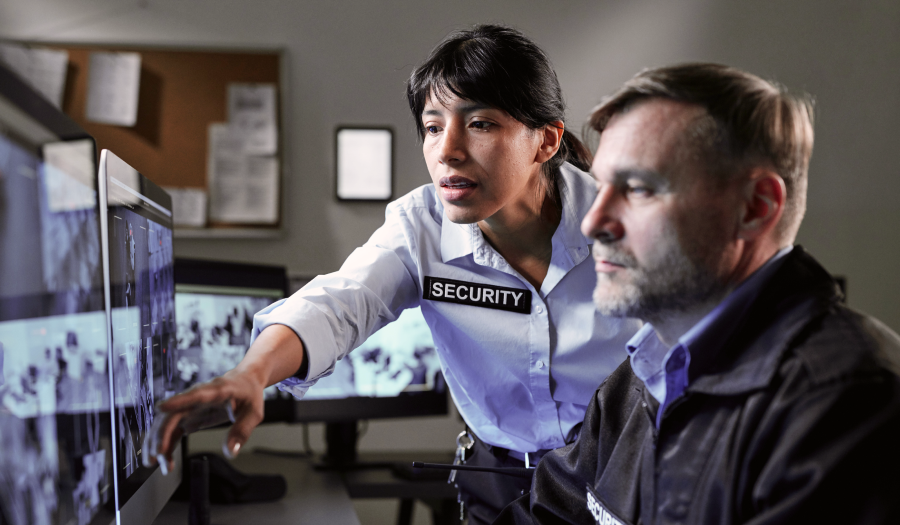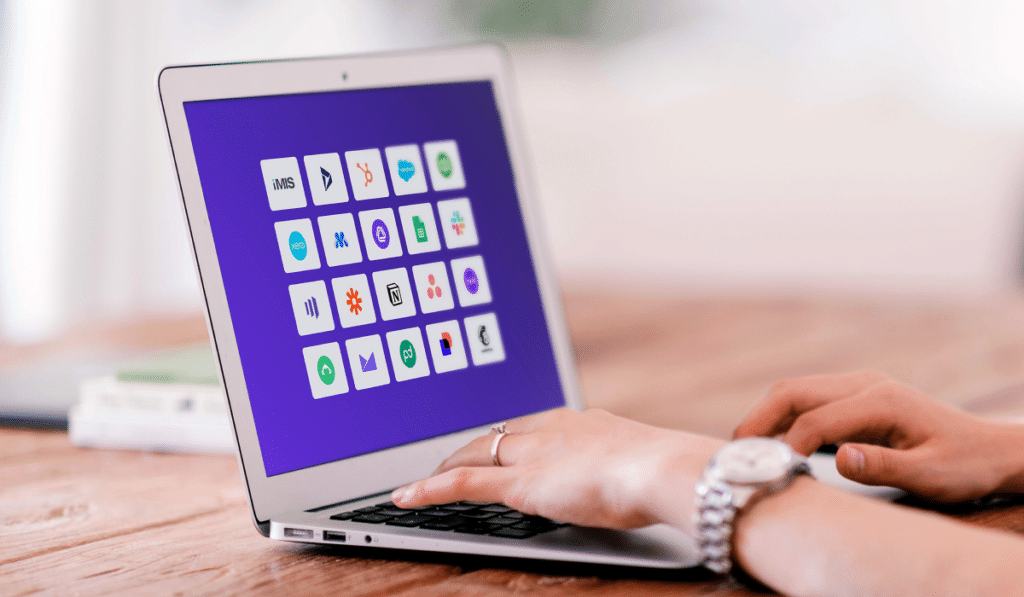How to price sponsorship packages for events

Brands love sponsoring events. In fact, in 2021, businesses spent $65.8 billion worldwide on event sponsorships, and this amount is expected to grow even more by 2024.
But, like any product, pricing is a significant factor in securing sponsorships. In this EventsAir guide, we’ll show you how to price event sponsorship packages to strike the perfect balance between conversions and ROI.
What are sponsorship packages?
Sponsorship packages are bundles of benefits and promotional opportunities you offer companies in exchange for financial support. They typically include branding opportunities, speaking slots, exclusive access to attendees, and similar perks.

For example, partner opportunities for AirTime 2024 included everything from a Platinum Partnership to Venue Partner, and even a Gamification Sponsor. Each package provided exclusive benefits like exhibition booths, networking opportunities, and promotional features in conference materials.
How to price sponsorship packages for events
1. Identify your target sponsors
Sponsorship packages are products. They’re designed to help specific people (and companies) accomplish specific things – and understanding the who and the what is absolutely crucial to pricing them correctly.
So, who are you targeting with your sponsorship packages? Create a persona that highlights details like:
- Industry (e.g., SaaS)
- Sponsor size (e.g., enterprise)
- Sponsor revenue (e.g., more than $55 million)
- Sponsor goals (e.g., increasing brand awareness, generating leads, etc.)
But beyond just the who, consider what your event offers that makes it attractive to your target sponsors:
- Event size: If you’re hosting a large event, it will provide greater exposure opportunities.
- Attendees: Is your audience composed of senior executives, decision-makers, or industry professionals? Highlighting the industry, job seniority, and job titles of attendees can be a big draw.
- Location: Whether your event is local, national, or global, this can impact the sponsor’s potential reach and appeal.
By presenting both the audience and the unique opportunities that your event provides, you can offer sponsorship packages that align with your target sponsors’ goals.
2. Analyze historical data
Review data from past events to understand what sponsorship packages were most successful in terms of revenue generation, attendee engagement, and sponsor satisfaction. If a premium sponsorship package with exclusive branding during keynote sessions was successful previously, consider offering similar packages for your next event to boost revenue.
At EventsAir, our event analytics and reporting software help you set goals based on accurate data. We can track your progress and make any necessary adjustments.
3. Analyze the market
Look at what similar events are offering and at what price points. Many events publish sponsorship packages and prices on their websites. Many others are happy to share info if you email them.
So, it’s fairly easy to build up a database that includes relevant details like:
- Packages
- Pricing
- Event attendance
- Sponsorship revenue
Then, when it’s time to set your own pricing, you can be super granular about how you position your packages relative to the field. You wouldn’t want to price yourself out of potential sponsorships because your packages aren’t in line with industry expectations.
4. Account for engagement
Not all sessions, activities, and speakers are equally valuable to sponsors. There are a number of factors at play here, including:
- Visibility: The number of people who will see the sponsor’s branding and messaging.
- Target audience: How well the event’s attendees align with the sponsor’s target market.
However, one factor planners often overlook is engagement. Sponsors want to see not only how many people they can reach but also how engaged those individuals are with the opportunity and its content. High engagement almost always means higher ROI.
To maximize engagement, offer opportunities for sponsors to directly connect with attendees. You can do this through speaking slots, participation in panels, exclusive round tables, or similar interactive formats.
Moreover, with an event management platform like EventsAir, you can build sponsorship packages around:
- Live polls
- Quizzes
- Gamification elements
…and more.
You can also use our lead capture tool to let your sponsors generate leads, track attendee engagement, and quantify their brand’s visibility with the right audience. By measuring their interaction with new leads in real time, your sponsors can boost their chances of success.
You can offer all these features as value-adds within premium packages to increase engagement.
5. Consider your sponsor’s expected ROI
Evaluate your sponsor’s expected return on investment (ROI) based on the benefits they can expect from their sponsorship. If you have past event data, this can be a very data-driven process—and the analysis can be used as a sales asset.
For example, say your target sponsors are mainly interested in boosting engagement (and revenue). You’d look into past event data to analyze similar sponsorships based on engagement metrics like:
- How many attendees interacted with their booth or digital assets
- Engagement level during their sessions
- The reach and visibility their brand achieved during the event— tracked through session attendance, audience engagement, and gamification tools
Then, you’d charge sponsors a percentage (typically 15-25%) of the expected ROI. So, if past sponsors generated an average of 150 leads worth an average of $800, you could justify pricing the package at 15-25% of $120,000 (or $18,000 to $30,000).
This value-based approach is easy to sell, and it allows for a win-win situation for you and the sponsor. You can confidently sell their sponsorship package at a fair price, while the sponsor can expect a solid ROI.
6. Create package tiers
Offer multiple levels of sponsorship like Bronze, Silver, and Gold, each with different benefits and visibility.
For example:
- Bronze Package can include basic benefits like logo placement on the event website and a mention during the program.
- Silver Package can have mid-level benefits such as a booth in the exhibition area, a social media shoutout, and an event app feature.
- Gold Package can offer top-tier benefits, including keynote sponsorship, premium branding across all event materials, and exclusive networking opportunities.
With EventsAir, you can easily customize different levels of sponsorship based on the specific needs of your event.
Along with these tiered options, offer custom packages that suit your sponsor’s needs and goals.
This lets your sponsor create their own package by selecting benefits that matter most, like enhancing brand visibility or accessing unique promotional opportunities
Custom sponsorship packages enhance value, making it easier to attract new sponsors and retain current ones by clearly showing how your event aligns with their objectives.
7. Calculate costs
Factor in all costs associated with delivering the sponsorship benefits.
Include both direct costs (printing promotional materials, renting event spaces, purchasing giveaways) and indirect costs (staff time spent coordinating events, communicating with sponsors, managing logistics).
To align your pricing with market standards, research similar sponsorship offerings to get an idea of average pricing in your industry. This will help you set your costs in line with what your sponsor expects, rather than just basing them on cost calculations.
Another option at this stage is offering sponsorships that offset specific costs. For example, to offset your live streaming costs at a hybrid event, you can offer a sponsorship package with logo placement on the live stream.
8. Be flexible with your pricing
Before finalizing, consider being flexible not only with your pricing, but also with the inclusions you offer.
Instead of focusing only on price adjustments, offer custom packages that provide more value to your sponsors. This way, even if you’re unwilling to lower the price, you’ll still be meeting their needs through inclusions that matter most to them.
With EventsAir, you can also create “what if…” budgets to test different pricing approaches and event scenarios. This gives you peace of mind that your pricing is competitive and reflects the value you offer.
Price your sponsorship packages with EventsAir
Pricing sponsorship packages effectively is crucial for event success. If you take your time and dive into the data, you’ll be rewarded with better margins, happier sponsors, and a more successful event.
Looking for a platform to help you draw these data insights? EventsAir helps organizers collect and organize event data, create pricing scenarios, and collaborate with sponsors to fine-tune sponsorship packages.
Request a demo to see how EventsAir can help your next event.



